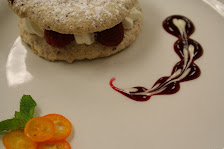Day 16: Sugar and friends.
Well, patient readers, ours was no slow reentry into the world of learning; we began the moment we walked in with an exercise in cooking sugar. Sugar goes through stages as it’s cooked (with water, usually), named for the way the sugar behaves when cooled… thread, soft and hard ball, soft and hard crack, and finally caramel. We were all thoroughly impressed when Chef got the boiling sugar (yes, boiling) into the bowl of ice water by means of his fingertips. Certainly chilling his hand in the ice water beforehand helped, but they’re undoubtedly made of brass anyway.
We then went on to learn two different methods of making fudge. The first, which I will wholeheartedly recommend to almost everyone from now on, would be to head down to your local Price Chopper and see what you can dig up. You’ll find this first route easier by a considerable margin. Alternatively, for those people I wish to see become extremely fatigued and frustrated, I would recommend that they make their own. You begin by boiling sugar syrup, enriched with dairy, to the proper temperature – no stirring, as that would encourage the sugar to recrystallize, and we’re looking for smooth here. When that’s finished, you stir in chocolate (ours was Valrhona; apparently it’s still Christmas), and then heat the whole mess back up to two hundred forty degrees or so, again without stirring. This step only takes about sixty or seventy minutes, during which you can do whatever you want, as long as you stay right by the mixture, to make sure it doesn’t boil too violently or get agitated by a rogue stirrer who may be lurking around your kitchen. (If you can come up with a list of things to do while meeting that requirement, let’s hear it.) It’s surprisingly difficult to fight the urge to stir while you stand by watching something boil happily away. That hour or so spent, you pour the mixture slowly onto a giant marble slab, dot it with butter and whatever flavoring you’re using, and then, using a scraper, you fold the edges of it into the center over and over again. (Think of that I Love Lucy episode where she and Ethel spend the day working at the candy factory. Yeah, that one.) Here’s where all that time you were enjoying not stirring is paid back. You fold the mixture continuously for maybe thirty or so more minutes. The really fun part of this stage is that as time goes by and your arm becomes more and more tired, the mixture gradually becomes much more difficult to work with. Then, just as you reach the limit of what you’re willing to go through to make food, you add nuts, which immediately cools the mixture and makes it stiffer. This would be fine if you were done mixing, which you aren’t. After about fifteen more minutes of slapping this stuff around you are allowed to put it into a buttered dish so it can finally actually turn into fudge. How people ever had the stamina to figure out that you could do this is beyond my understanding.
It was really good fudge, though, I have to say.
Next, we moved on to the last country whose meringue we will be investigating: Italy. In contrast to the French method, where sugar is added directly, or the Swiss, where sugar is heated with the egg whites, the Italian meringue is made by adding blisteringly hot sugar syrup to whipping egg whites. This meringue has the same proportion of ingredients as the others, but is significantly more stable. The drawback is that it’s pretty elaborate. The egg whites and the syrup both have to be at the correct stages at the exact same moment before they can be combined, and then the syrup must be drizzled in at the right speed while a giant beater is revolving around the mixing bowl, trying to flick it everywhere but where it’s supposed to go. There were hardened globs of sugar syrup pretty much everywhere. I think I’ll stick with the Swiss method. As in a previous lesson, we went on to saturate our meringue with butter, tint it, and then pipe it out into cockle shells, fine as fivepence.
And they looked better this time.
Wednesday, January 3, 2007
Subscribe to:
Post Comments (Atom)































































No comments:
Post a Comment